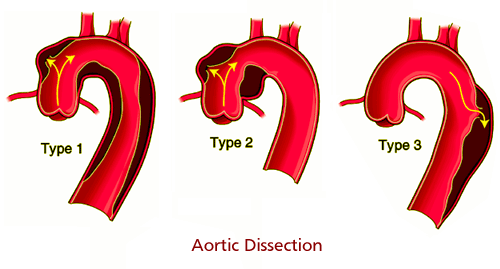Aortic Dissection Causes, Symptoms, Diagnosis and Treatment

What Is Aortic Dissection?
An aortic dissection is a serious condition in which the inner layer of the aorta, the large blood vessel branching off the heart, tears.
Blood surges through the tear, causing the inner and middle layers of the aorta to separate (dissect).
Aortic dissection is a medical emergency and can quickly lead to death, even with optimal treatment, as a result of decreased blood supply to other organs, heart failure, and sometimes rupture of the aorta.
The treatment of aortic dissection depends on the part of the aorta involved. Surgery is usually required for dissections that involve the aortic arch, while dissections of the part further away from the heart may be treated with blood pressure lowering only.
An aortic dissection can lead to:
- Death due to severe internal bleeding
- Organ damage, such as kidney failure or life-threatening intestinal damage
- Stroke
- Aortic valve damage (aortic regurgitation) or rupture into the lining around the heart (cardiac tamponade)
Aortic dissections are divided into two groups, depending on which part of the aorta is affected: - Type A. This more common and dangerous type involves a tear in the part of the aorta where it exits the heart or a tear in the upper aorta (ascending aorta), which may extend into the abdomen.
- Type B. This involves a tear in the lower aorta only (descending aorta), which may also extend into the abdomen.
Causes Of Aortic Dissection:
An aortic dissection occurs in a weakened area of the aortic wall.
The exact cause is yet unknown, but more common risks include:
- Aging
- Atherosclerosis
- Blunt trauma to the chest, such as hitting the steering wheel of a car during an accident
- High blood pressure
- Bicuspid aortic valve
- Coarctation (narrowing) of the aorta
- Connective tissue disorders (such as Marfan syndrome and Ehlers-Danlos syndrome) and rare genetic disorders
- Heart surgery or procedures
- Pregnancy
- Swelling of the blood vessels due to conditions such as arteritis and syphilis
Symptoms Of Aortic Dissection:
Signs and symptoms include:
- Sudden severe chest or upper back pain, often described as a tearing, ripping or shearing sensation, that radiates to the neck or down the back
- Loss of consciousness
- Shortness of breath
- Sudden difficulty speaking, loss of vision, weakness or paralysis of one side of the body, similar to those of a stroke
- Weak pulse in one arm compared with the other
- Anxiety and a feeling of doom
- Fainting or dizziness
- Heavy sweating (clammy skin)
- Nausea and vomiting
- Pale skin (pallor)
- Pain in the abdomen
- Stroke symptoms
- Swallowing difficulties from pressure on the esophagus
Diagnosis Of Aortic Dissection:
The following tests are conducted in order to diagnose aortic dissection:
- Transesophageal echocardiogram (TEE).
- Computerized tomography (CT) scans.
- Magnetic resonance angiogram (MRA).
Treatment Of Aortic Dissection:
Treatment depends upon the type of aortic dissection.
- Type A aortic dissection
Surgery
Medications
o beta blockers
o nitroprusside - Type b aortic dissection
Surgery
Medications
By : Natural Health News




